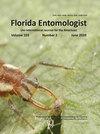黑樱桃作为美国乔治亚州农业生态系统中臭蝽(半翅目:蝽科)的寄主植物
IF 1.2
4区 农林科学
Q3 ENTOMOLOGY
引用次数: 3
摘要
摘要臭蝽(半翅目:蝽科)是一种多食性害虫,在食物供应后从林地栖息地扩散到作物中。黑樱桃(Prunus serotina Ehr.;Rosaceae)在美国东南部很常见。在这项为期3年的研究中,我们的主要目标是确定黑樱桃是否是繁殖宿主,以及美国乔治亚州与作物相邻的林地栖息地中蝽的食物来源。每年,除了使用信息素引诱的树冠和地面陷阱捕捉黑樱桃树外,还对其进行了蝽种类和阶段的视觉检查。2016年,我们比较了树冠诱捕器和地面诱捕器捕获的蝽的数量。在研究的每一年的诱捕器中都检测到了中华鳖(Chinavia hilaris Say)、服务扁尾蠊(Euscitus servus)(Say),三尖扁尾蝽(Euschistus tristigmus)(Say)和绿色扁尾蠊(Nezara viridula)(均为半翅目:Pentatomicae)。在2016年的测试中,地面诱捕器中的蝽总数(1.53±0.07)明显高于树冠诱捕器(0.71±0.07。在视觉采样过程中,仅在树上发现了肺门梭菌(99.2%)和绿色猪笼草(0.8%)。在这两种采样方法中,在黑樱桃中都检测到了肺门梭菌的卵块、大多数龄期和成虫的两性。该物种的若虫与成虫的比例在诱捕器中为1:1,在视觉样本中若虫偏向。无尾虫(Howard)(膜翅目:真翅目)(44%)、三尖虫(膜翅目:Scelionidae)(35%)和Ooencyrtus sp。绿尾蠊若虫与成虫的比例存在成虫偏误。servus和tristigmus的若虫和成虫都被诱捕器捕获;然而,大多数人都是成年人。我们的结论是,黑樱桃是一个重要的繁殖宿主和一个食物来源。然而,我们的研究结果表明,对于其他3种蝽来说,它更像是一种食物来源,而不是繁殖宿主。本文章由计算机程序翻译,如有差异,请以英文原文为准。
Black Cherry as A Host Plant For Stink Bugs (Hemiptera: Pentatomidae) in Agroecosystems in Georgia, USA
Abstract Stink bugs (Hemiptera: Pentatomidae) are polyphagous pests that disperse from woodland habitats into crops following food availability. Black cherry (Prunus serotina Ehrh.; Rosaceae) is common in the southeast US. In this 3-yr study, our principal objective was to determine if black cherry acts as a reproductive host as well as a source of food for stink bugs in woodland habitats adjacent to crops in Georgia, USA. Each yr, black cherry trees were examined visually for stink bug species and stages in addition to using pheromone-baited canopy and ground traps to capture them. In 2016, we compared the number of stink bugs captured in canopy traps versus ground-based traps. Chinavia hilaris Say, Euschistus servus (Say), Euschistus tristigmus (Say), and Nezara viridula (L.) (all Hemiptera: Pentatomidae) were detected in traps each yr of the study. Total number of stink bugs was significantly higher in ground traps (1.53 ± 0.07) compared to canopy traps (0.71 ± 0.07) in the 2016 test. Only C. hilaris (99.2%) and N. viridula (0.8%) were found on trees during visual sampling. Over both types of sampling methods, egg masses, most instars, and both sexes of adults of C. hilaris were detected in black cherry. The nymph to adult ratio for this species was 1:1 in traps and nymph biased in visual samples. Anastatus reduvii (Howard) (Hymenoptera: Eupelmidae) (44%), Trissolcus edessae Fouts (Hymenoptera: Scelionidae) (35%), and Ooencyrtus sp. (Hymenoptera: Encyrtidae) (21%) emerged from C. hilaris egg masses. The nymph to adult ratio for N. viridula was adult biased. Both nymphs and adults of E. servus and E. tristigmus were captured in traps; however, the majority of individuals were adults. We conclude that black cherry is a significant reproductive host and a food source for C. hilaris. However, our results indicate that it serves as a food source more so than a reproductive host for the other 3 stink bug species.
求助全文
通过发布文献求助,成功后即可免费获取论文全文。
去求助
来源期刊

Florida Entomologist
生物-昆虫学
CiteScore
2.10
自引率
7.10%
发文量
44
审稿时长
3 months
期刊介绍:
Florida Entomologist is the official journal of the Florida Entomological Society. Volumes 1-3 were published under the name The Florida Buggist. The Florida Entomological Society still produces the traditionally printed version of Florida Entomologist, but you can also view, search, or print any article published since June 1917 by accessing online files. Web access is made possible by the Society’s electronic publication project begun in 1993
 求助内容:
求助内容: 应助结果提醒方式:
应助结果提醒方式:


